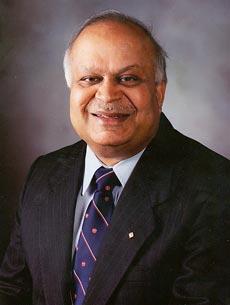
As modern civilization has grown more dependent on electric power, the need to maintain a reliable and secure power grid has become an imperative. Power grids have become larger and more complex with society's changing needs, but keeping tabs on such vast systems in real-time requires ever-more ingenious techniques. Arun Phadke and James Thorp have helped meet this imperative by creating tools for grid-wide measurements and a methodology to act on these measurements quickly, leading to dramatically improved power reliability and security. They have been at the forefront of the move to replace electro-mechanical protection systems with substantially more effective computer-based relays.
Phadke and Thorp pioneered the development of hardware and software that led to widespread industry use of a new kind of protective relay—the devices used to monitor and protect the power grid. Until the early 1980s protective relays had limited abilities. They measured voltage and current and then removed equipment from the system if it failed. Phadke and Thorp recognized that, by using a computer in place of the electro-mechanical heart of the original relay, the new device could do more than just monitor and record. Computer-based relays scattered around the grid could act as individual intelligent units to diagnose problems, communicate them to a central hub and adapt. Phadke and Thorp also tied these relays to a GPS clock—the subsequent precise synchronization helps provide a wide—area snapshot of the grid, a key tool to protect against blackouts when the power grid is under stress. The resulting immediacy of information available from all parts of the grid was a major breakthrough for monitoring and protection.
Over a span of 30 years, the two engineers—Phadke, focused on concepts and hardware and Thorp, the theoretician—helped realize the incredible potential that microcomputer-based techniques could offer power systems. Together they revolutionized the field.
Born in 1938, Arun Phadke earned his B.S. in 1955 from Agra University in India. He went on to receive a B.T. in 1959 from the Indian Institute of Technology, Khargpur, an M.S.E.E. in 1961 from the Illinois Institute of Technology and a Ph.D. in 1964 from the University of Wisconsin-Madison. Between 1963 and 1982 he worked in the electric utility industry, the last 13 years of which were at the American Electric Power Service Corporation (AEP). There, along with theoretician Thorp, who joined him at AEP in 1976-1977 while on a sabbatical leave from Cornell, Phadke explored the application of computers to high-voltage transmission substations.
In 1982 Phadke accepted a faculty position at Virginia Tech, while remaining as a consultant to AEP until 1990. Phadke holds five patents. He has published over 150 journal and proceedings papers and has written or contributed to 22 books. He is a Fellow of the Institute of Electrical and Electronics Engineers (IEEE) and a member of the National Academy of Engineering. His scientific awards include the IEEE Herman Halperin Electric Transmission and Distribution Award, the IEEE Power Engineering Society Technical Committee Distinguished Service Award and the International Council on Large Electric Systems (CIGRE) Technical Committee Award.
Information as of April 2008

